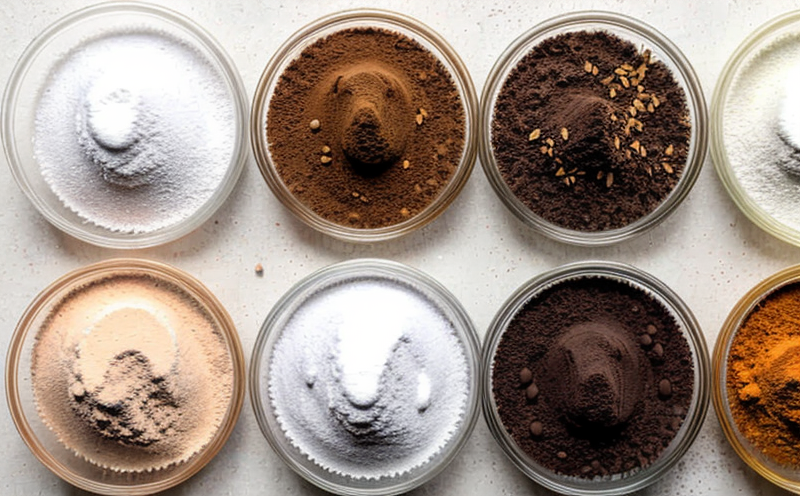EN 21942 Anthocyanin Detection in Berry Products
The European Standard EN 21942 specifies a method for the quantitative determination of anthocyanins in berry products, including fruits like strawberries, blueberries, and blackberries. This standard is crucial for quality assurance in food and feed production, ensuring that sweeteners and colorants derived from these berries meet international safety and labeling requirements.
Anthocyanins are natural pigments found in many fruits and vegetables, particularly those with dark colors such as blueberries and blackberries. These compounds play a vital role in the visual appeal of food products but also contribute to their nutritional value by acting as antioxidants. The accurate quantification of anthocyanins is essential for maintaining consistent product quality and ensuring compliance with international standards.
The procedure outlined in EN 21942 involves several key steps, starting with sample preparation. This typically includes homogenizing the berry products to ensure uniform distribution of anthocyanins. The extracted solutions are then analyzed using spectrofluorometric methods, which provide precise and reliable results. This technique allows for the detection of anthocyanins even in low concentrations, making it suitable for both quality control and research applications.
The standard also emphasizes the importance of sample storage conditions to prevent degradation of anthocyanins, which can occur due to exposure to light or air. Proper handling and preparation are critical to obtaining accurate results, as any alteration in the chemical structure of the anthocyanins could lead to misinterpretation during analysis.
The acceptance criteria for this test are stringent but necessary for ensuring product integrity. Any deviations from these criteria may indicate issues with ingredient sourcing or processing methods, which could impact both the sensory attributes and nutritional profile of the final product. Compliance with EN 21942 ensures that food manufacturers can confidently market their products as natural and authentic.
Quality managers and compliance officers rely on accurate anthocyanin detection to maintain brand reputation and consumer trust. For R&D engineers, this standard offers a reliable method for optimizing production processes and developing new formulations. Procurement teams benefit from consistent supplier performance by ensuring that raw materials meet the required specifications.
Implementing EN 21942 not only enhances product quality but also supports broader sustainability goals by promoting the use of natural ingredients over synthetic alternatives. This standard aligns with global trends towards more transparent and sustainable food production, making it an essential tool for businesses operating in this sector.
Eurolab Advantages
At Eurolab, we pride ourselves on providing unparalleled expertise in food and feed testing. Our team of highly skilled analysts ensures that every test adheres to the highest standards set by international organizations such as ISO, ASTM, EN, IEC, and others.
We leverage state-of-the-art equipment and methodologies to deliver precise results, enabling our clients to make informed decisions about their product development and quality assurance processes. With a deep understanding of the regulatory landscape, we help businesses navigate complex compliance requirements confidently.
Our commitment to excellence is reflected in our flexible service offerings tailored to meet specific client needs. Whether you require one-off tests or ongoing monitoring, we offer scalable solutions that fit seamlessly into your operational workflow.
In addition to technical proficiency, Eurolab emphasizes strong communication and collaboration throughout the testing process. Our dedicated support team ensures that all inquiries are addressed promptly, fostering a partnership that drives mutual success.
Customer Impact and Satisfaction
The impact of accurate anthocyanin detection extends far beyond mere compliance; it directly influences consumer satisfaction and brand loyalty. By ensuring consistent quality in sweeteners and colorants derived from berries, Eurolab helps manufacturers deliver products that meet or exceed customer expectations.
For our customers, this means enhanced market competitiveness through reliable data supporting product claims. It also translates into reduced risk of recalls or legal actions due to non-compliance with regulations. Ultimately, satisfied customers translate into increased sales and brand reputation growth.
We continuously strive to exceed expectations by providing robust evidence-based reports that inform strategic business decisions. Our services are designed not only to comply with existing standards but also anticipate future trends in food safety and quality assurance.
Use Cases and Application Examples
The application of EN 21942 is wide-ranging, encompassing various sectors within the food industry. Here are some specific use cases:
Quality Control in Production: Regular testing ensures that each batch of berry products meets specified anthocyanin content levels, maintaining uniformity across production runs.
New Product Development: R&D teams can use this method to explore different extraction techniques and formulation adjustments aimed at optimizing the natural color profile of new products.
Supply Chain Management: By verifying compliance with international standards, companies can ensure that their suppliers are delivering high-quality raw materials consistently.
Sustainability Initiatives: This standard supports efforts to reduce reliance on artificial colorants by encouraging the use of natural alternatives sourced directly from berries.
Market Compliance: Ensuring that all products comply with regional and international regulations helps prevent legal issues and maintains a positive public image.





